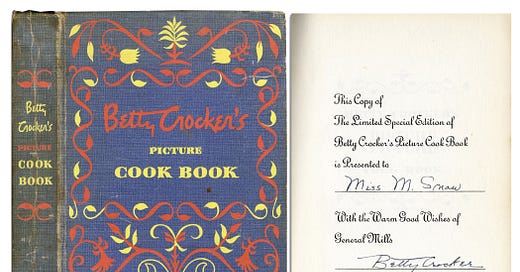Writers: Fictional: Betty Crocker
What a Piece of Work I Am, Chapter 38:
ARIANE SPENT a lot of time in the kitchen, of course. She was intrigued by the idea of making the meals improve the illusion. She included a lot of fruit, and she used a lot of fish. That was the first thing that occurred to her. Although the library had no cookbooks devoted to tropical cuisines, she was able to get ideas from travel books, and she prowled through the complete works of Betty Crocker looking for recipes with any of the ingredients that seemed tropical to her, particularly pineapple and coconut.
Wikipedia, “Betty Crocker” and “Betty Crocker Cookbook”:
Betty Crocker is a brand and fictional character used in advertising campaigns for food and recipes. […]
The character was developed in 1921 following a unique Gold Medal Flour promotion featured in the Saturday Evening Post. The ad asked consumers to complete a jigsaw puzzle and mail it to the then Washburn-Crosby Company, later General Mills, in Minneapolis, Minnesota. In return, they would receive a pincushion shaped like a bag of flour. Along with 30,000 completed puzzles came several hundred letters with cooking-related questions.
Realizing that especially housewives would want advice from a fellow woman, the company’s Advertising Department convinced its board of directors to create a personality that the women answering the letters could all use in their replies. The name Betty was selected because it was viewed as a cheery, all-American name. It was paired with the last name Crocker, in honor of William Crocker, a Washburn Crosby Company director.
The portrait of Betty Crocker was first commissioned in 1936. It has been updated seven times since her creation, reflecting changes in fashion and hairstyles. […]
In 1945, Fortune magazine named Betty Crocker the second most popular woman in America; Eleanor Roosevelt was named first. In the same year, Fortune “outed” Betty Crocker as a fictitious creation, calling her a “fake” and a “fraud.”
First published on September 8, 1950, with an initial print run of 950,000 copies, as Betty Crocker’s Picture Cook Book, the first edition sold for $2.95, with a $3.95 deluxe edition available. […] The 2,161[!] recipes for the book were developed by a team of 50 chefs at the General Mills test kitchens, supervised by the home economist Janette Kelley. The book was an immediate best-seller and contemporary reviews were positive; the Chicago Tribune declared it the best general cookbook ever published, and The New York Times noted that its sales of 18,000 copies a week were several times that of the most recent Ernest Hemingway novel.

Foreshadowing
What a Piece of Work I Am, Chapter 38:
She wanted to be inside the fiction, an actor in the play, not a stagehand behind the scenes.
[to be continued]
Have you missed an episode or two or several?
You can begin reading at the beginning or you can catch up by visiting the archive or consulting the index to the Topical Guide. The Substack serialization of Little Follies begins here; Herb ’n’ Lorna begins here; Reservations Recommended begins here; Where Do You Stop? begins here; What a Piece of Work I Am begins here.
You can listen to the episodes on the Personal History podcast. Begin at the beginning or scroll through the episodes to find what you’ve missed. The Substack podcast reading of Little Follies begins here; Herb ’n’ Lorna begins here; Reservations Recommended begins here; Where Do You Stop? begins here; What a Piece of Work I Am begins here.
You can listen to “My Mother Takes a Tumble” and “Do Clams Bite?” complete and uninterrupted as audiobooks through YouTube.
You can ensure that you never miss a future issue by getting a free subscription. (You can help support the work by choosing a paid subscription instead.)
At Apple Books you can download free eBooks of Little Follies, Herb ’n’ Lorna, Reservations Recommended, and Where Do You Stop?
You’ll find overviews of the entire work in An Introduction to The Personal History, Adventures, Experiences & Observations of Peter Leroy (a pdf document), The Origin Story (here on substack), Between the Lines (a video, here on Substack), and at Encyclopedia.com.




